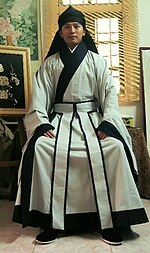| Shenyi | |||||||||
|---|---|---|---|---|---|---|---|---|---|
 Modern reproduction of a Confucian shenyi. | |||||||||
| Chinese name | |||||||||
| Chinese | 深衣 | ||||||||
| Literal meaning | Deep clothing | ||||||||
| |||||||||
| Vietnamese name | |||||||||
| Vietnamese alphabet | Áo thâm y | ||||||||
| Hán-Nôm | 襖深衣 | ||||||||
| Korean name | |||||||||
| Hangul | 심의 | ||||||||
| Hanja | 深衣 | ||||||||
| Literal meaning | Profound gown | ||||||||
| |||||||||
Shenyi (Chinese: 深衣; pinyin: shēnyī; lit. 'deep clothing'; Korean: 심의; Hanja: 深衣; RR: Simui; yr: sim.ui), also called Deep garment in English,[1]: 12 [2]: 135 means "wrapping the body deep within the clothes"[1]: 12 or "to wrap the body deep within cloth".[2]: 135 The shenyi is an iconic form of robe in Hanfu,[3] which was recorded in Liji and advocated in Zhu Xi's Zhuzi jiali《朱子家禮》.[4] As cited in the Liji, the shenyi is a long robe which is created when the "upper half is connected to the bottom half to cover the body fully".[3] The shenyi, along with its components,[5] existed prior to the Zhou dynasty[6][7] and appeared at least since the Shang dynasty.[3] The shenyi was then developed in Zhou dynasty with a complete system of attire, being shaped by the Zhou dynasty's strict hierarchical system in terms of social levels, gender, age, and situation and was used as a basic form of clothing.[3] The shenyi then became the mainstream clothing choice during the Qin and Han dynasties.[3] By the Han dynasty, the shenyi had evolved into two types of robes: the qujupao (Chinese: 曲裾袍) and the zhijupao (Chinese: 直裾袍).[1]: 13–14 The shenyi later gradually declined in popularity around the Wei, Jin, and Northern and Southern dynasties period.[3] However, the shenyi's influence persisted in the following dynasties.[3] The shenyi then became a form of formal wear for scholar-officials in the Song and Ming dynasties.[8] Chinese scholars also recorded and defined the meaning of shenyi since the ancient times, such as Zhu Xi in the Song dynasty, Huang Zongxi in the Ming dynasty, and Jiang Yong in the Qing dynasty.[3]
The shenyi was also introduced in both Goryeo and Japan, where it exerted influences on Confucian clothing attire in Korea and Japan. The shenyi is called simui in Korean, it was worn by followers of Confucianism in the Goryeo and Joseon period.[6][9]
- ^ a b c Hua, Mei (2011). Chinese Clothing. Cambridge: Cambridge University Press. ISBN 9780521186896. OCLC 1277432082.
- ^ a b Lynch, Annette; Strauss, Mitchel D. (2014). Ethnic dress in the United States : a cultural encyclopedia. Lanham, Maryland: Rowman & Littlefield Publishers. ISBN 9780759121508. Retrieved 3 February 2021.
- ^ a b c d e f g h Kuo, Y.-P.; Vongphantuset, J.; Joneurairatana, E. (November 16, 2021). "View of From Eastern inspiration to unisex fashion: a case study on traditional Chinese Shenyi attire". Silpakorn University, Thailand. Retrieved March 2, 2022.
- ^ Theobald, Ulrich (2013). "Zhuzi jiali 朱子家禮". www.chinaknowledge.de. Retrieved 2022-06-23.
- ^ Zhao, Yin; Cai, Xinzhi (2014). Snapshots of Chinese Culture. Los Angeles: Bridge21 Publications. ISBN 9781626430037. OCLC 912499249.
- ^ a b "심의 (深衣)" [Simui]. Encyclopedia of Korean Culture (in Korean).
- ^ "Liji : Wang Zhi《王制 - Wang Zhi》". ctext.org (in Chinese (Taiwan)). Retrieved 2022-06-23.
有虞氏皇而祭,深衣而養老。夏后氏收而祭,燕衣而養老。殷人冔而祭,縞衣而養老。周人冕而祭,玄衣而養老。
- ^ Wang, Chen (2014-09-01). "Conservation study of Ming dynasty silk costumes excavated in Jiangsu region, China". Studies in Conservation. 59 (sup1): S177–S180. doi:10.1179/204705814X13975704319154. ISSN 0039-3630. S2CID 191384101.
- ^ "심의 (深衣)" [Simui]. Encyclopedia of Korean Folk Culture. Retrieved 2022-03-20.